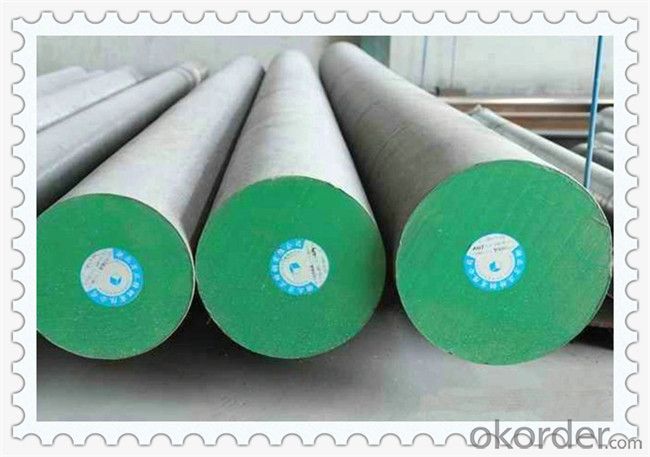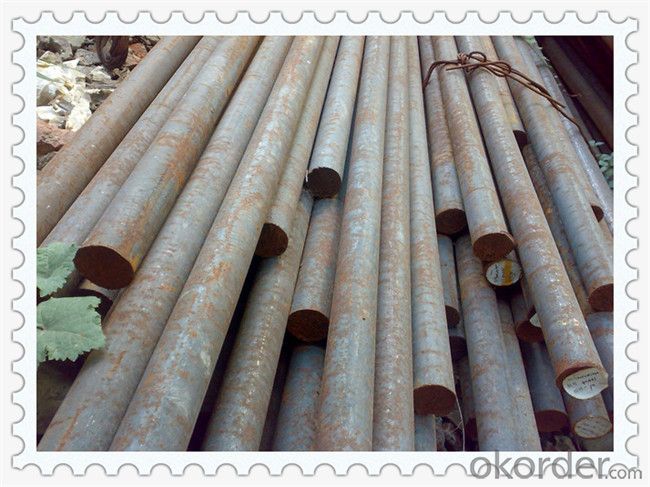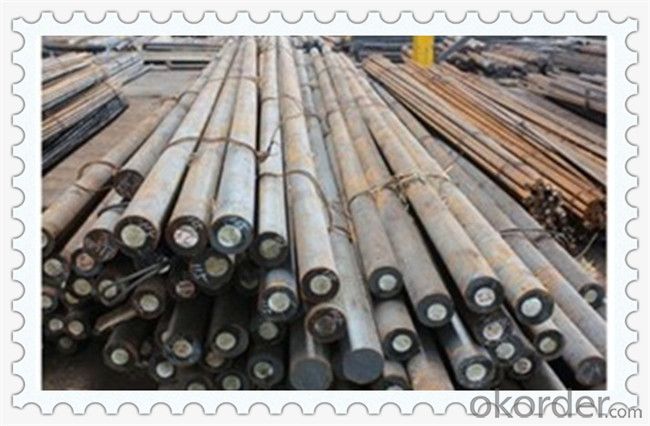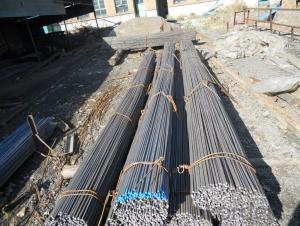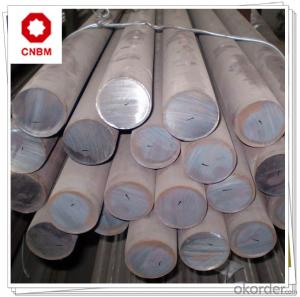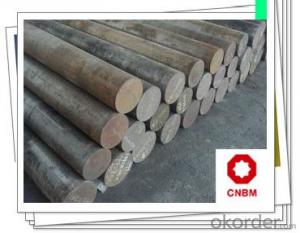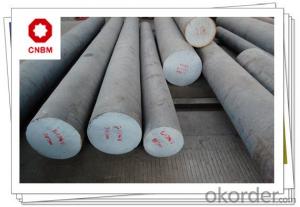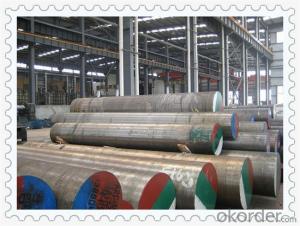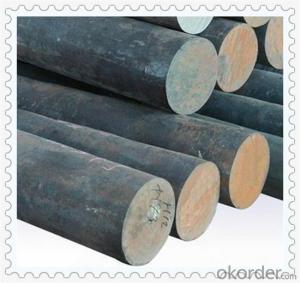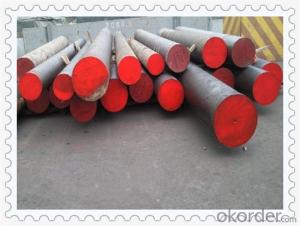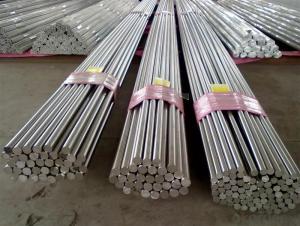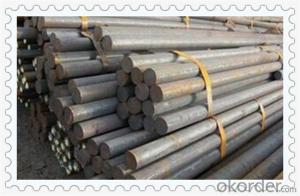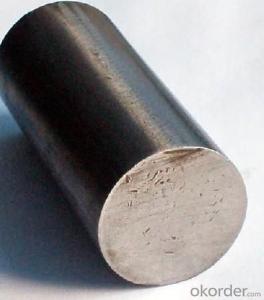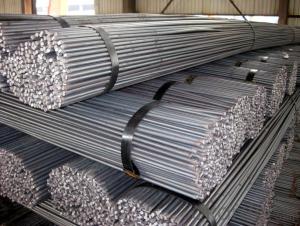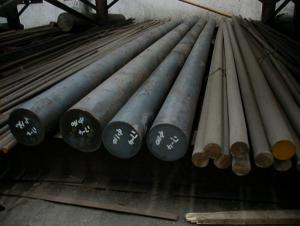Carbon Steel Rod SAE 1045 Round Steel Bar
- Loading Port:
- China main port
- Payment Terms:
- TT OR LC
- Min Order Qty:
- 50 m.t.
- Supply Capability:
- 10000 m.t./month
OKorder Service Pledge
OKorder Financial Service
You Might Also Like
Carbon Steel Rod SAE 1045 Round Steel Bar
Technical Paramenters
Chemical Composition | Mechanical Properties (In Quenched & Tempered State) | ||
C | 0.43-0.50 % | Tensile strength(MPA) | ≥600(61) |
Si | 0.17-0.37 % | Yield strength (MPA) | ≥355(36) |
Mn | 0.60-0.90 % | Elongation (δ5/%) | ≥16 |
Cr | ≤0.25 % | Reduction in Area (ψ/%) | ≥40 |
Ni | ≤0.30 % | Impact (J) | ≥ 39 |
P | ≤0.040 % | Impact toughness value αkv (J/cm2) | ≥49(5) |
S | ≤0.050 % | Hardness | ≤229HB |
Cu | ≤0.25 % | ||
Products Show

Product Overviews
| Product Name | Typical Grades | Diameter(mm) | Standard adopted |
| Carbon Steel | 20 (1020/S20C/C22) | Ø16-Ø300 |
GB/SAE/JIS/DIN
|
| 40 (1040/S40C/C40) | |||
| 45 (1045/S45C/C45) | |||
| Bearing Steel | GCr9 (51100/SUJ1) | Ø12-Ø250 | |
| GCr15 (52100/SUJ2/100Gr6) | |||
| GCr9SiMn (A485-Gr.1/SUJ3) | |||
Cr-Mo Steel | 20Cr (5120/SCr420H/20Cr4) | Ø12-Ø250 | |
| 40Cr (5140/SCr440/41Cr4) | |||
| 42CrMo(4140/SCM440/42CrMo4) | |||
| Gear Steel | 20CrNiMo | Ø16-Ø600 | |
| 20CrMn(5115/SMnC420/20MnCr5) | |||
| 20CrNiMo(8620/SNCM220/20CrMiMo2) |
Work Shop

Company Information
CNBM International Corporation is the most important trading platform of CNBM group.
Whith its advantages, CNBM International are mainly concentrate on Cement, Glass, Iron and Steel, Ceramics industries and devotes herself for supplying high qulity series of refractories as well as technical consultancies and logistics solutions.


FAQ
1, Your advantages?
professional products inquiry, products knowledge train (for agents), smooth goods delivery, excellent customer solution proposale
2, Test & Certificate?
SGS test is available, customer inspection before shipping is welcome, third party inspection is no problem
3, Factory or Trading Company?
CNBM is a trading company but we have so many protocol factories and CNBM works as a trading department of these factories. Also CNBM is the holding company of many factories.
4, Payment Terms?
30% TT as deposit and 70% before delivery.
Irrevocable L/C at sight.
5, Trading Terms?
EXW, FOB, CIF, FFR, CNF
6, After-sale Service?
CNBM provides the services and support you need for every step of our cooperation. We're the business partner you can trust.
For any problem, please kindly contact us at any your convenient time.
We'll reply you in our first priority within 24 hours.
Packaging & Delivery
1, Packaging: seaworthy package or as required
2, Delivery: 35-45 days or based on quantity

- Q: What are the different packaging options for steel round bars?
- Customers have various packaging options to choose from when it comes to steel round bars, depending on their specific needs and requirements. Some commonly used packaging options include: 1. Bundles: Steel round bars can be bundled together using steel straps or wire to create a compact and secure package. The bundles come in different sizes, ranging from 2 to 5 tons, and are suitable for transportation and storage purposes. 2. Wooden Crates: For enhanced protection during transportation, steel round bars can be packed in wooden crates. These crates are designed to withstand the weight and size of the bars, ensuring safe delivery to the customer. 3. Steel Cages: In certain situations, steel round bars are packaged in steel cages or racks to provide additional stability and security during transportation. These cages are typically made of sturdy steel and can be stacked, making them suitable for storage as well. 4. Plastic Wrapping: To safeguard the steel round bars from moisture, dust, and other contaminants, they can be wrapped in plastic or shrink wrap. This packaging option is commonly used when the bars are stored or transported in open-air environments. 5. Customized Packaging: Depending on the customer's specific requirements, steel round bars can be packaged in custom-designed containers or crates. These can be tailored to accommodate different sizes, weights, and quantities of bars, ensuring maximum convenience and safety during handling and transportation. It is important to note that the choice of packaging option may vary based on factors such as the destination, mode of transportation, and specific industry standards. Therefore, customers are advised to consult their suppliers or packaging experts to determine the most suitable packaging option for their steel round bars.
- Q: Can steel round bars be used for making medical equipment?
- Medical equipment can indeed be made using steel round bars. Steel is a versatile and durable material that is commonly used in the manufacturing of medical instruments and equipment. It possesses excellent strength and can withstand high levels of stress and pressure, making it suitable for a wide range of medical applications. Moreover, steel's resistance to corrosion and its ability to be easily sterilized ensure that the medical equipment remains hygienic and safe for use. Steel round bars can be machined, shaped, and formed into various medical instruments such as surgical tools, implants, braces, and prosthetics. Therefore, steel round bars are a viable option for producing medical equipment due to their strength, durability, and compatibility with sterilization processes.
- Q: What are the advantages of using steel round bars in construction?
- There are several advantages of using steel round bars in construction. Firstly, steel round bars offer exceptional strength and durability, making them ideal for supporting heavy loads and withstanding harsh weather conditions. Secondly, they are highly resistant to corrosion, ensuring long-lasting and low-maintenance structures. Additionally, steel round bars can be easily customized and shaped to fit various construction needs, allowing for flexibility in design. Lastly, steel round bars are readily available and cost-effective, making them a preferred choice for construction projects.
- Q: Are steel round bars resistant to UV radiation?
- No, steel round bars are not inherently resistant to UV radiation.
- Q: Can steel round bars be used for making power transmission systems?
- Certainly! Power transmission systems can indeed be made using steel round bars. Various industries commonly use steel round bars because of their remarkable strength and durability. Their capacity to endure high torque and load capacities makes them suitable for power transmission systems. Steel round bars can be machined and shaped into different sizes and forms, offering versatility for diverse power transmission applications. Moreover, steel exhibits exceptional wear resistance and can withstand severe operating conditions, rendering it an ideal material for power transmission systems that necessitate enduring performance.
- Q: How do you store excess steel round bars?
- In order to maintain the longevity of excess steel round bars and prevent any damage, it is imperative to adhere to specific guidelines. Here are several measures that can be implemented: 1. It is essential to thoroughly clean and examine the steel round bars prior to storage. Remove all traces of dirt, grease, or moisture from the surface to hinder corrosion. 2. Opt for an appropriate storage location. Ideally, select a well-ventilated, dry area with stable temperatures. Avoid areas that are susceptible to moisture, extreme heat, or direct sunlight when storing the bars. 3. Implement the use of racks or pallets for bar storage. Arrange them horizontally, one on top of the other, ensuring there is ample space between each layer to prevent any deformation or bending. 4. If the bars are to be stored outdoors, ensure they are covered with a waterproof tarp or a protective coating to safeguard against rain, snow, and other elements. 5. Refrain from placing excessive weight on top of the bars to prevent deformation. Additionally, exercise caution regarding any sharp objects or edges in close proximity that could potentially cause damage. 6. Regularly inspect the stored bars to detect any signs of corrosion, rust, or other damage. If any issues are identified, promptly address them by taking the necessary measures. It is crucial to bear in mind that proper storage is paramount to preserve the quality and integrity of the steel round bars. By adhering to these guidelines, one can ensure that the excess steel round bars remain in optimal condition until they are required for future use.
- Q: What are the advantages of using high-temperature steel round bars?
- Using high-temperature steel round bars in various applications has several advantages. Firstly, these bars possess excellent heat resistance properties, enabling them to withstand elevated temperatures without compromising their structural integrity. This makes them ideal for industries like aerospace, automotive, and power generation, where components are exposed to extreme heat conditions. Another advantage of high-temperature steel round bars is their superior strength and durability. They are designed to withstand high mechanical stresses, making them suitable for applications requiring heavy loads or intense pressure. Additionally, their high strength-to-weight ratio allows for lighter and more efficient designs, reducing overall material and production costs. Furthermore, high-temperature steel round bars exhibit excellent corrosion resistance properties. They can withstand exposure to harsh environments, including chemicals, moisture, and saltwater, without significant degradation. This makes them suitable for industries like marine, chemical, and oil and gas where corrosion resistance is crucial. Moreover, high-temperature steel round bars offer excellent dimensional stability, maintaining their shape and size even under extreme temperature fluctuations. This property is highly advantageous in applications where precision and accuracy are essential, such as machining and tooling. Lastly, high-temperature steel round bars are readily available in various sizes, grades, and finishes, allowing for flexibility and customization to meet specific project requirements. This versatility makes them suitable for a wide range of applications, ensuring that there is a suitable option for every project, regardless of complexity or industry. In conclusion, high-temperature steel round bars provide superior heat resistance, strength, durability, corrosion resistance, dimensional stability, and versatility. These properties make them an excellent choice for various industries and applications, guaranteeing reliable and long-lasting performance in demanding environments.
- Q: What is the difference between a forged and a ground steel round bar?
- The manufacturing processes and resulting characteristics of a forged steel round bar and a ground steel round bar differ significantly. To create a forged steel round bar, the steel is subjected to high temperatures and then shaped using mechanical pressure, typically with a hammer or press. This process aligns the grain structure of the steel, enhancing its strength and durability. The forged steel round bars are renowned for their exceptional strength, impact resistance, and overall toughness. They find widespread use in applications that demand high strength, such as heavy machinery, automotive parts, and construction equipment. On the contrary, a ground steel round bar is manufactured using a grinding process. Once the steel is initially shaped, it undergoes precise grinding to achieve the desired dimensions and surface finish. This grinding process eliminates any imperfections or irregularities on the surface, resulting in a smooth and polished appearance. Ground steel round bars are commonly employed in applications that necessitate precise dimensions, like shafts, axles, and precision tools. In conclusion, the primary distinction between a forged steel round bar and a ground steel round bar lies in their manufacturing processes and resultant properties. The forged steel round bar offers superior strength and toughness due to the alignment of its grain structure, making it a suitable choice for heavy-duty applications. Conversely, the ground steel round bar is renowned for its precise dimensions and polished surface finish, rendering it an ideal option for applications that require precision.
- Q: What is the tensile strength of a steel round bar?
- The tensile strength of a steel round bar depends on various factors such as the specific grade of steel, the manufacturing process, and any additional treatments or coatings applied. Generally, steel round bars have high tensile strength due to their composition and structural design. The specific tensile strength can vary significantly depending on the grade of steel. For example, low carbon steel typically has a tensile strength of around 400-550 MPa (megapascals), while high carbon steel can have a tensile strength of 700-1000 MPa or even higher. It's worth noting that the tensile strength of a steel round bar can be further enhanced by heat treatment processes such as quenching and tempering, which can significantly increase its strength and hardness. Additionally, certain alloying elements like chromium, nickel, and molybdenum can be added to steel to improve its tensile strength and other mechanical properties. To determine the exact tensile strength of a specific steel round bar, it is crucial to refer to the manufacturer's specifications or consult relevant industry standards such as ASTM (American Society for Testing and Materials) or AISI (American Iron and Steel Institute) standards. These standards provide detailed information on the mechanical properties, including tensile strength, for various grades of steel.
- Q: Can steel round bars be used in the pharmaceutical industry?
- Yes, steel round bars can be used in the pharmaceutical industry. Steel round bars are commonly used in various industries, including pharmaceuticals, due to their strength, durability, and versatility. In the pharmaceutical industry, steel round bars can be utilized for a range of applications such as manufacturing equipment, machinery, and storage systems. These bars can be used to construct pharmaceutical manufacturing equipment like mixers, reactors, and centrifuges, which require robust and reliable materials to ensure efficiency and safety in pharmaceutical production processes. Additionally, steel round bars can be employed in the construction of storage systems such as racks and shelves, providing a sturdy and secure solution for organizing pharmaceutical products and supplies. The corrosion resistance and ease of cleaning of steel make it suitable for maintaining hygienic conditions in pharmaceutical facilities. Overall, steel round bars offer the pharmaceutical industry a reliable and cost-effective material option for various applications.
Send your message to us
Carbon Steel Rod SAE 1045 Round Steel Bar
- Loading Port:
- China main port
- Payment Terms:
- TT OR LC
- Min Order Qty:
- 50 m.t.
- Supply Capability:
- 10000 m.t./month
OKorder Service Pledge
OKorder Financial Service
Similar products
Hot products
Hot Searches
Related keywords








